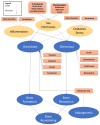Protective Effects of Selected Botanical Agents on Bone
- PMID: 29751644
- PMCID: PMC5982002
- DOI: 10.3390/ijerph15050963
Protective Effects of Selected Botanical Agents on Bone
Abstract
Osteoporosis is a serious health problem affecting more than 200 million elderly people worldwide. The early symptoms of this disease are hardly detectable. It causes progressive bone loss, which ultimately renders the patients susceptible to fractures. Osteoporosis must be prevented because the associated fragility fractures result in high morbidity, mortality, and healthcare costs. Many plants used in herbal medicine contain bioactive compounds possessing skeletal protective effects. This paper explores the anti-osteoporotic properties of selected herbal plants, including their actions on osteoblasts (bone forming cells), osteoclasts (bone resorbing cells), and bone remodelling. Some of the herbal plant families included in this review are Berberidaceae, Fabaceae, Arecaceae, Labiatae, Simaroubaceaea, and Myrsinaceae. Their active constituents, mechanisms of action, and pharmaceutical applications were discussed. The literature shows that very few herbal plants have undergone human clinical trials to evaluate their pharmacological effects on bone to date. Therefore, more intensive research should be performed on these plants to validate their anti-osteoporotic properties so that they can complement the currently available conventional drugs in the battle against osteoporosis.
Keywords: bone remodelling; complementary therapies; herbal medicine; osteoblast; osteoclast.
Conflict of interest statement
The authors report no conflicts of interest in this work.
Figures
References
-
- Lama A., Santoro A., Corrado B., Pirozzi C., Paciello O., Pagano T.B., Russo S., Calignano A., Mattace Raso G., Meli R. Extracorporeal shock waves alone or combined with raloxifene promote bone formation and suppress resorption in ovariectomized rats. PLoS ONE. 2017;12:e0171276. doi: 10.1371/journal.pone.0171276. - DOI - PMC - PubMed
-
- Sucuoglu H., Koyuncu H. Distribution of male osteoporosis patients according to age, classification, and fracture. Istanb. Med. J. 2017;18:13–17. doi: 10.5152/imj.2016.26234. - DOI
Publication types
MeSH terms
LinkOut - more resources
Full Text Sources
Other Literature Sources
Medical


